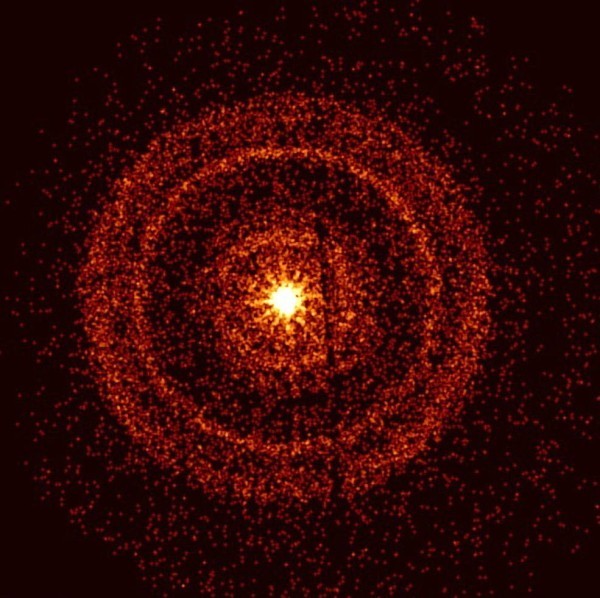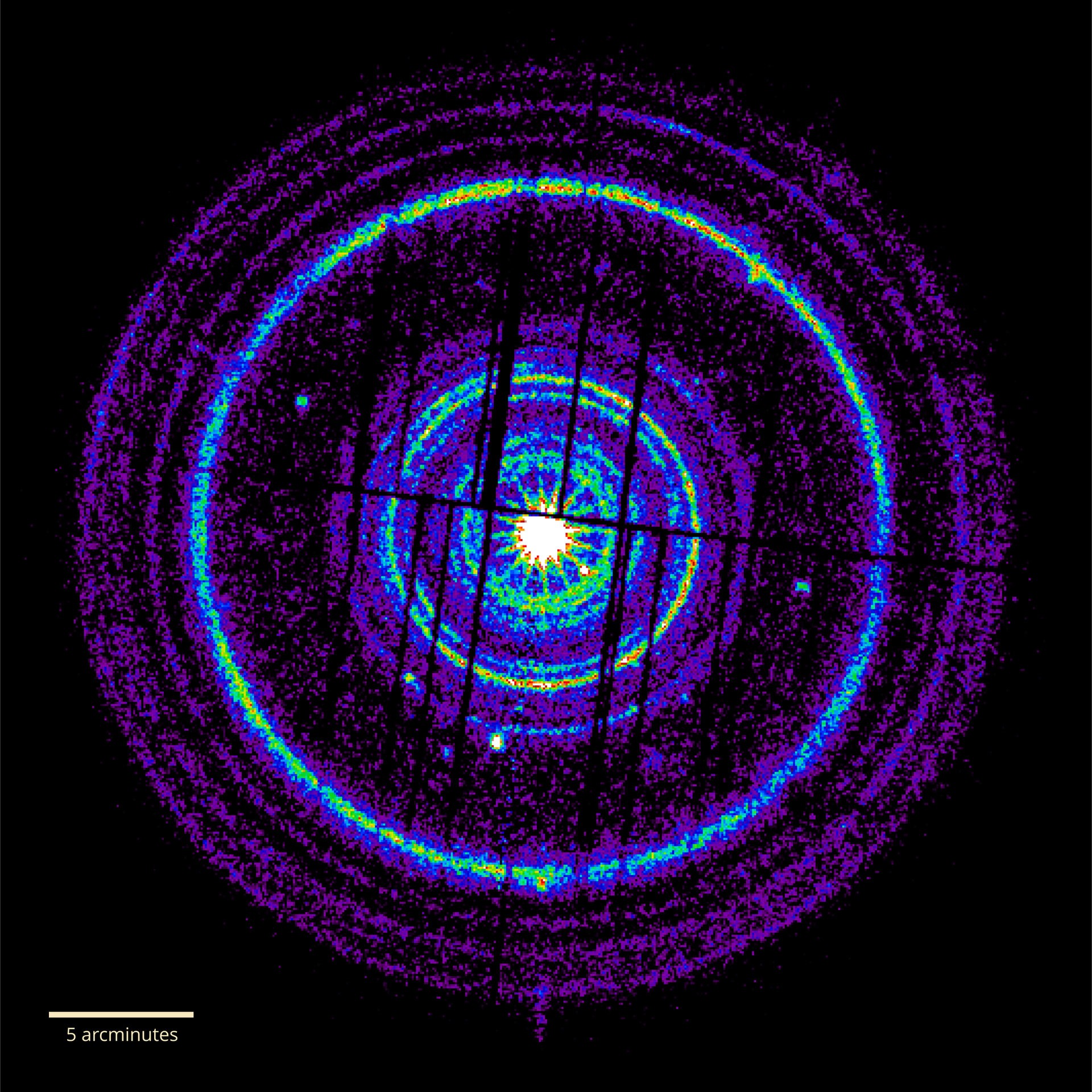UA astronomers discuss historic gamma-ray burst and scientists’ next steps

The brightest ever Gamma-Ray Burst illuminates the sky on October 9, 2022, captured an hour later in this image, showcasing the X-ray scattered rings formed by dust layers in our galaxy. (Image Credit: NASA, Swift, A. Beardmore – University of Leicester)
April 14, 2023
On Oct. 9, 2022, the sky was illuminated with a spectacular display of light when the brightest gamma-ray burst ever witnessed in history, GRB 221009A, occurred. The event was visible to the naked eye and observed by astronomers around the world, including a team of scientists at the University of Arizona.
Today, those scientists are working with colleagues around the globe to analyze the data collected from the Hubble Space Telescope and other observatories worldwide to further our understanding of the nature of gamma-ray bursts and their role in the evolution of the universe.
The discovery of this gamma-ray burst is significant for several reasons. According to David Sand, an associate professor in the department of astronomy at the UA, this burst was the brightest seen on Earth in 55 years.
“GRB 221009A was a truly remarkable event that has provided us with invaluable information about the nature of gamma-ray bursts,” Sand said. “It was a once-in-a-lifetime event that we were lucky enough to witness and study in real-time.”
Gamma-ray bursts are one of the most energetic phenomena in the universe, occurring when massive stars collapse or when two neutron stars merge. They emit short bursts of gamma rays, the most energetic form of light. The study of gamma-ray bursts is important because they can tell us about the early universe and the physics of extreme environments.
The results of this finding could have important effects on astronomy and astrophysics.
Kate Alexander, assistant professor in the department of astronomy, explained that gamma-ray bursts are some of the most extreme events in the universe, and understanding them can provide insights into the fundamental laws of physics.
“By studying the properties of gamma-ray bursts, we can learn about the formation and evolution of galaxies, the origins of heavy elements and the behavior of matter under extreme conditions,” Alexander said.
The next steps following this event are to continue to analyze the data gathered during the burst and compare it to theoretical models. Manisha Shrestha, a postdoctoral research associate at the UA, explained that the data collected will be analyzed for years to come.
“We will use this data to test and refine our models of gamma-ray bursts, and to better understand the physics behind these powerful events,” Shrestha said.
The challenges encountered while studying this phenomenon were numerous. Gamma-ray bursts are infrequent and unpredictable, making it difficult to study them in real time. This poses one of the biggest hurdles to examining the explosion.
Sand explained that the team at the UA used a combination of ground-based telescopes and space-based observatories to study the burst.
“We had to act quickly to get observations of the burst in as many wavelengths as possible, including radio, optical and X-ray,” Sand said.

New technologies and strategies are being investigated to further improve our knowledge of gamma-ray bursts. Alexander explained that new observatories, such as the Cherenkov Telescope Array and the James Webb Space Telescope, will provide even more detailed observations of gamma-ray bursts and other extreme phenomena in the universe.
“These new observatories will allow us to study the early universe and the most extreme environments in the universe with unprecedented precision,” Alexander said.
The discovery of GRB 221009A was the result of collaborative efforts between astronomers and scientists from around the world. Sand explained that the UA team collaborated with researchers from institutions such as the National Center for Supercomputing Applications and the University of California, Santa Cruz.
“We worked together to analyze the data and compare it to theoretical models to better understand the properties of gamma-ray bursts,” Sand said.
The discovery has bettered our understanding of the cosmos and its complexities. Shrestha explained that the study of gamma-ray bursts can help us answer fundamental questions about the universe, such as how galaxies are formed and how stars evolve. She also emphasized that the study of GRBs can provide insights into the nature of the universe’s most extreme environments and physical processes, such as black holes and the behavior of matter under extreme conditions.
Regarding potential future discoveries and developments in the study of GRBs, Sand is optimistic.
“There’s always something new to learn, and new telescopes and instruments are constantly being developed that can help us see further and deeper into the universe,” Sand said.
Overall, gamma-ray burst research is a constantly evolving field that holds immense potential for uncovering new insights about the universe and its workings. The recent discovery of GRB 221009A has given new excitement to the world’s astronomers, showing them there is still much more to be discovered. This discovery has only led to more collaboration among astronomers and astrophysicists.
“We are just scratching the surface of what we can learn from these incredible events,” Alexander said. “It’s an exciting time to be studying gamma-ray bursts, and we look forward to continuing to work with our colleagues around the world to unravel their mysteries.”
Follow Jason Dayee on Twitter


